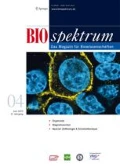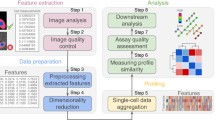Abstract
Automated high-throughput microscopy has been instrumental for drug discovery and large-scale gene perturbation screens. Advancements in image resolution, microscope speed, and detection sensitivity have greatly aided high-content imaging approaches. Here, we describe how high-content microscopy can be repurposed for quantitative image-based cytometry, an approach that exploits both the throughput and the resolution of current screening microscopes for multidimensional cell population analyses.
Similar content being viewed by others
Literatur
Altmeyer M, Toledo L, Gudjonsson T et al. (2013) The chromatin scaffold protein SAFB1 renders chromatin permissive for DNA damage signaling. Mol Cell 52:206–220
Ochs F, Somyajit K, Altmeyer M et al. (2016) 53BP1 fosters fidelity of homology-directed DNA repair. Nat Struct Mol Biol 23:714–721
Pellegrino S, Michelena J, Teloni F et al. (2017) Replication-coupled dilution of H4K20me2 guides 53BP1 to pre-replicative chromatin. Cell Rep 19:1819–1831
Toledo LI, Altmeyer M, Rask MB et al. (2013) ATR prohibits replication catastrophe by preventing global exhaustion of RPA. Cell 155:1088–1103
Lukas J, Lukas C, Bartek J (2011) More than just a focus: the chromatin response to DNA damage and its role in genome integrity maintenance. Nat Cell Biol 13:1161–1169
Mankouri HW, Huttner D, Hickson ID (2013) How unfinished business from S-phase affects mitosis and beyond. EMBO J 32:2661–2671
Lezaja A, Altmeyer M (2017) Inherited DNA lesions determine G1 duration in the next cell cycle. Cell Cycle 17:24–32
Arora M, Moser J, Phadke H et al. (2017) Endogenous replication stress in mother cells leads to quiescence of daughter cells. Cell Rep 19:1351–1364
Barr AR, Cooper S, Heldt FS et al. (2017) DNA damage during S-phase mediates the proliferation-quiescence decision in the subsequent G1 via p21 expression. Nat Commun 8:14728
Yang HW, Chung M, Kudo T et al. (2017) Competing memories of mitogen and p53 signalling control cell-cycle entry. Nature 549:404–408
Spencer SL, Cappell SD, Tsai FC et al. (2013) The proliferation-quiescence decision is controlled by a bifurcation in CDK2 activity at mitotic exit. Cell 155:369–383
Strauss R, Bartek J (2018) Daughters sense their mother’s stress. Cell Cycle 17:145–146
Author information
Authors and Affiliations
Corresponding author
Additional information
Aleksandra Lezaja Molekularbiologiestudium an der Universität Belgrad, Serbien. Masterarbeit an der Universität Genf, Schweiz. Seit 2016 Doktorandin im Cancer Biology PhD Programm der Universität Zürich.
Matthias Altmeyer Biologiestudium an der Universität Konstanz. Doktorarbeit an der Universität Zürich, Schweiz. Mehrjähriger Forschungsaufenthalt als Postdoc an der Universität Kopenhagen, Dänemark. Seit 2014 SNF-Förderungsprofessor und Leiter einer Forschungsgruppe zum Thema „Quantitative Zellbiologie der Genomstabilität“ an der Universität Zürich.
Rights and permissions
About this article
Cite this article
Lezaja, A., Altmeyer, M. High-content imaging für multidimensionale Zellanalysen. Biospektrum 24, 269–272 (2018). https://doi.org/10.1007/s12268-018-0918-5
Published:
Issue Date:
DOI: https://doi.org/10.1007/s12268-018-0918-5




